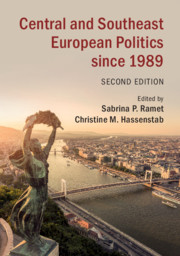Book contents
- Central and Southeast European Politics since 1989
- Central and Southeast European Politics since 1989
- Copyright page
- Dedication
- Contents
- Figures and Maps
- Tables
- Contributors
- Preface
- Glossary
- Guide to the Pronunciation of Central and Southeast European Words
- Additional material
- Part One Introduction
- Part Two Issues
- Part Three Central Europe
- Part Four Yugoslav Successor States
- 10 Slovenia since 1989
- 11 Politics in Croatia since 1990
- 12 Serbia and Montenegro since 1989
- 13 Bosnia-Herzegovina since 1991
- 14 Macedonia/North Macedonia since 1989
- 15 Kosova
- Part Five Southeastern Europe
- Part Six Present and Future Challenges
- Index
- References
12 - Serbia and Montenegro since 1989
from Part Four - Yugoslav Successor States
Published online by Cambridge University Press: 16 September 2019
- Central and Southeast European Politics since 1989
- Central and Southeast European Politics since 1989
- Copyright page
- Dedication
- Contents
- Figures and Maps
- Tables
- Contributors
- Preface
- Glossary
- Guide to the Pronunciation of Central and Southeast European Words
- Additional material
- Part One Introduction
- Part Two Issues
- Part Three Central Europe
- Part Four Yugoslav Successor States
- 10 Slovenia since 1989
- 11 Politics in Croatia since 1990
- 12 Serbia and Montenegro since 1989
- 13 Bosnia-Herzegovina since 1991
- 14 Macedonia/North Macedonia since 1989
- 15 Kosova
- Part Five Southeastern Europe
- Part Six Present and Future Challenges
- Index
- References
Summary
The transition of Serbia and Montenegro may be said to have begun in 1987, when Slobodan Miloševic, a banker-turned-politician, seized power in Serbia. Miloševic subsequently put his own people in charge in Montenegro. Although there were other players, Miloševic was the key player in igniting war in Croatia (1991–1995) and Bosnia-Herzegovina (1992–1995), supplying local Serb insurgents with weapons and training. By 1992, Serbia (including Kosovo) and Montenegro were united in a common state. But after the war, both Montenegro and Kosovo sought independence. Montenegro achieved independence in 2006, while Kosovo obtained its independence in 2008. Serbia continues to wrestle with history, with some Serbs refusing to acknowledge that, as a collaborator with Adolf Hitler, Serbia’s leader during World War Two, Milan Nedic, was complicit in war crimes. Both states wrestle with unemployment, while the European Values Study for 2008 found that Serbs were well below the European average for confidence in their parliament.
- Type
- Chapter
- Information
- Central and Southeast European Politics since 1989 , pp. 309 - 341Publisher: Cambridge University PressPrint publication year: 2019



